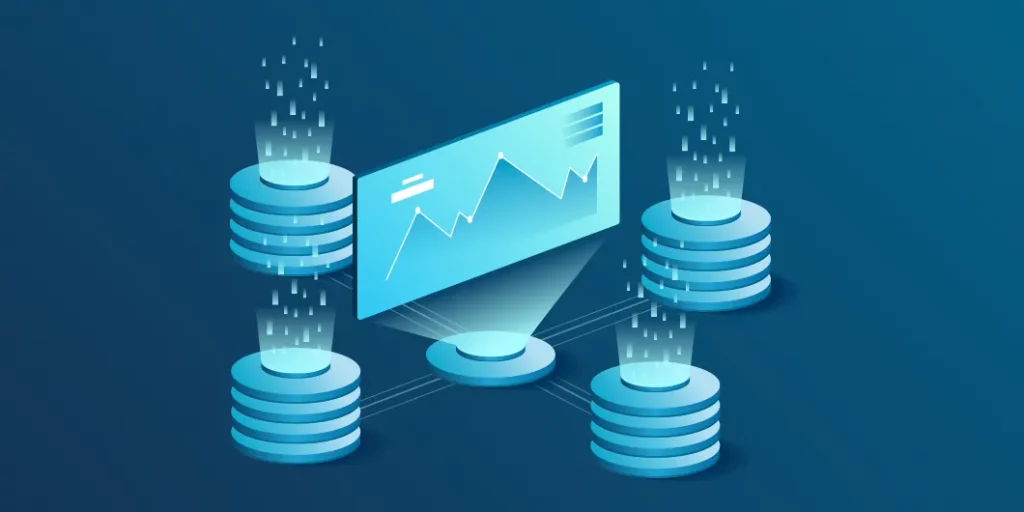Blockchain isn’t just a buzzword. It is a wealth of information. Every transaction, wallet interaction, and network activity is recorded transparently and permanently. But how does this data help to forecast cryptocurrency prices? Let us break it down.
What is Blockchain Data?
Blockchain data is the backbone of every blockchain network. It is essentially the detailed log of every interaction within the system. This includes information like wallet addresses, transaction amounts, timestamps, and network activity. At its core, it is an open ledger that anyone can access.
Key Components of Blockchain Data
- Transactions: Records of funds moving between wallets.
- Wallet Addresses: Unique identifiers for participants.
- Hash Rate: The computing power used to maintain and secure the blockchain.
- Token Movements: Tracks how tokens flow through the system.
- Network Growth: Measures how the blockchain expands over time, from new wallets to increased activity.
How Blockchain Data is Used in Price Prediction
Blockchain data is more than just a record of the past; it also provides insights into the present and possible future. Traders and analysts use on-chain metrics to gain a better understanding of market dynamics.
On-Chain Metrics
- Transaction Volume: Tracks how actively a token is being traded. Higher volume can signal increased interest.
- Active Addresses: The number of wallets interacting with the blockchain daily. A rise in active addresses often suggests growing adoption.
- Hash Rate: Reflects the security and health of proof-of-work networks like Bitcoin. Changes in hash rate can indicate shifts in miner sentiment.
- Token Movement: Shows how tokens move between wallets, exchanges, and storage. Large movements sometimes signal whale activity or market shifts.
- Network Growth: A steadily growing network often points to a healthy and expanding ecosystem, which can positively affect prices.
Blockchain Analytics Tools
Specialised tools, such as Glassnode, IntoTheBlock, and Nansen, analyse blockchain data to generate actionable insights. These platforms simplify raw data, allowing traders and investors to make informed decisions.
Market Sentiment and Blockchain Data
Market sentiment plays an important role in price prediction, and blockchain data frequently reflects sentiment indirectly. For example, an increase in transaction volume or token movement may indicate market excitement or fear.
Sentiment Indicators
- Blockchain Data as a Mirror: On-chain activity can reveal whether traders are feeling bullish or bearish.
- Social Media Integration: Some platforms combine blockchain data with social media trends to gauge market sentiment more holistically.
Predicting Price Trends with Blockchain Data
Blockchain data helps in spotting both long-term trends and short-term movements.
Long-Term Trends
Consistent network growth, increasing hash rates, and rising transaction volumes often suggest a positive outlook over time.
Short-Term Movements
Sudden spikes in token transfers to exchanges or high trading volumes can indicate an upcoming price shift.
Using Blockchain Data for Risk Management
Blockchain data is also valuable for managing risks. It helps identify periods of high volatility and potential corrections before they happen. For example, large transfers from wallets to exchanges could hint at upcoming sell-offs.
Complementary Analysis
Blockchain data works best when combined with technical and fundamental analysis. Together, they provide a well-rounded view of market dynamics.
Blockchain Data and Institutional Investors
Institutional investors have taken note of the value of blockchain data. They use it to monitor market activity, assess risks, and spot opportunities.
Institutional Impact
The presence of large players in blockchain data frequently results in increased stability or significant price fluctuations. Their activity can serve as a warning for retail traders.
Blockchain Data in Predictive Algorithms
Blockchain data is a treasure trove for AI and machine learning models. These models use the data to identify patterns and create predictive algorithms.
What’s Next?
As blockchain technology evolves, predictive models will become even more accurate. Advanced analytics may soon be able to forecast trends with a level of precision previously thought impossible.
Challenges in Using Blockchain Data
While blockchain data offers many benefits, it is not without its challenges.
- Data Overload: With so much data available, it can be overwhelming to identify what matters.
- Quality and Interpretation: Not all data is reliable. Misinterpreting data can lead to flawed predictions.
- Inaccuracies and Delays: Blockchain data is sometimes incomplete or delayed, which can impact its usefulness for real-time decisions.
Real-World Examples
Several traders and analytics firms have successfully used blockchain data to forecast price movements. For example, by tracking wallet activity and token flows, on-chain analysis assisted in forecasting the 2021 Bitcoin bull market. These examples demonstrate the value of actionable insights over raw data.
The Future of Blockchain Data
Blockchain analytics is still in its early stages, but the opportunities are enormous. As tools improve and adoption increases, blockchain data is likely to play an even larger role in shaping crypto markets. With advancements in analytics, increased adoption, and a better understanding of on-chain metrics, the future of price prediction appears bright.
Blockchain data is not just for cryptocurrency experts. With the right tools and understanding, it becomes a simple and effective way to navigate the volatile world of cryptocurrency markets. Whether you’re a retail trader, an institutional investor, or just curious, there’s a lot to gain from digging into the numbers.
